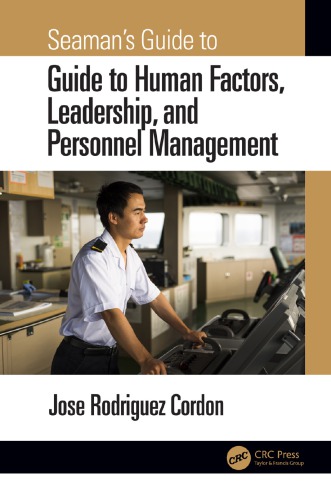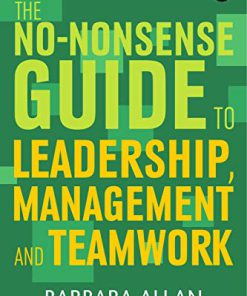Seaman Guide to Human Factors Leadership and Personnel Management 1st Edition by Jose Rodriguez Cordon 0429516207 9780429516207
$50.00 Original price was: $50.00.$25.00Current price is: $25.00.
Seaman s Guide to Human Factors Leadership and Personnel Management 1st Edition by Jose Rodriguez Cordon – Ebook PDF Instant Download/DeliveryISBN: 0429516207, 9780429516207
Full download Seaman s Guide to Human Factors Leadership and Personnel Management 1st Edition after payment.

Product details:
ISBN-10 : 0429516207
ISBN-13 : 9780429516207
Author: Jose Rodriguez Cordon
Training and certification for Seafarers has been founded on technical aspects, but maybe the most important thing to do aboard a ship is dealing with people. This book, written with seamen in mind, covers areas of expertise that every officer should know to improve motivation, engagement, teamwork, and conflict handling; in short, to be a leader. This book also covers the new requirements for every officer or merchant marine and can be used in courses on this topic. It focuses on seafarers’ needs and the language used, avoiding the excessive use of psychological terms, yet keeping the accuracy. Features Covers new requirements for every Merchant Marine Officer Written for and by a seaman, with the accuracy of a psychologist Presents knowledge on how to improve motivation, engagement, teamwork, and conflict handling Includes how to manage people in emergency situations and avoid the loss of lives, like the disaster of Costa Concordia and Estonia
Seaman s Guide to Human Factors Leadership and Personnel Management 1st Table of contents:
Chapter 1 Introduction
References
Chapter 2 Leadership
2.1 Leadership on Board
2.1.1 Definitions of Leadership
2.1.2 Focuses Centered on the Leader, Trait, or Process?
2.1.3 The Trait Approach
2.1.4 The Leadership Styles Approach
2.1.5 Contingency Models
2.1.5.1 Fielder’s Model
2.1.5.2 Hersey and Blanchard Situational Leadership Model
2.1.5.3 Model of Leader Participation
2.1.5.4 Path to the Goal Model
2.1.6 Leadership Models Focused on Followers: Implicit Leadership Theories
2.1.7 Leadership as a Process of Influence: Idiosyncratic Credit Theory
2.1.8 Charismatic Leadership
2.1.9 Transformational Leadership and Transactional Leadership
2.1.9.1 Transformational Leadership
2.1.10 Leadership and Intergroup Relations
2.1.11 Intergroup Phenomena
2.1.12 Intergroup Hostility
2.1.13 Intergroup Harmony
2.1.14 Leadership and Organizational Climate
2.1.15 Leadership and Job Satisfaction
2.1.16 Cross-Cultural Leadership
2.1.17 Leadership and Gender
2.1.18 Ethical Leadership and Authentic Leadership
2.2 THE EVIL LEADERSHIP: THE CASE OF MARIA M
2.2.1 The Crew
2.2.2 The Events
2.2.3 Human Factor
2.3 Leadership in Emergency Situations
2.3.1 Decision-Making Under Pressure
2.3.1.1 Role of the Cerebral Hemispheres in Emergency Situations
2.3.2 Fear: Psychological Reaction to an Emergency Situation
2.3.2.1 States of Fear and Forms of Appearance
2.3.2.2 Resilience (Ability to Overcome Adversity)
2.3.3 Reactions in Emergency Situations
2.3.4 Verbal Communication in Emergency Situations
2.3.5 Crew Training for Crowd Control
2.3.5.1 Chaos Is Inherent in All Emergencies
2.3.5.2 Training for Crowd Control
2.3.5.3 Special Emphasis on Information for Officers
2.3.6 How to Inform Passengers in Case of Emergency
2.3.6.1 Alarm Signals Are Not Enough
2.3.6.2 Responsibility Increases the Potential for Action
2.3.6.3 Authority Is a Prerequisite in Crowd Control
2.4 Catastrophe of the Estonia
2.4.1 The Crew
2.4.2 The Events
2.4.3 The Human Element
References
Chapter 3 Teamwork
3.1 Group Structure
3.1.1 Effects of Group Size
3.1.2 Effects of Group Diversity
3.1.3 Effects of the Combination of Individuals in the Group
3.1.4 The Concept of Group Structure
3.1.4.1 Intragroup Differentiation
3.1.4.2 Hierarchies in Groups
3.1.5 Group Regulations
3.1.5.1 Effects of Deviation with Respect to the Group Norms
3.1.5.2 The “Black Sheep” Effect
3.1.6 Group Roles
3.1.7 Processes of Influence Inside Groups
3.1.7.1 Conformism
3.1.7.2 Uncertainty and Consensus
3.1.7.3 Factors That Influence Conformism
3.1.8 Minority Influence
3.1.8.1 Mechanisms of Defense against Minority Influence
3.2 Productivity of the Group
3.2.1 Group Performance
3.2.2 Effects of the Public and Coercion on Productivity
3.2.2.1 Effects of Coordination and Motivation
3.3 Group Decision Processes: How Groups Make Decisions
3.3.1 Group Polarization
3.3.2 Biases and Limitations in Group Decision-Making
3.4 Group Thinking
3.4.1 Some Highlights of Intergroup Relations
3.5 Benefits of Teamwork
3.5.1 Characteristics of Effective Teams
3.5.2 Role of the Leader in Team Building
3.5.3 Stages in Team Building
3.5.4 Skills of Team Members
3.5.5 Self-Directed Teams
3.5.5.1 Formation of Self-Directed Teams
3.5.5.2 Types of Self-Directed Teams
3.5.5.3 Role of the Leader in Self-Directed Teams
3.5.6 Empowerment of Teams
3.6 Managing Diversity: Multicultural Crews
3.6.1 Diversity and Its Effects on Groups: General Investigations
3.6.2 Cultural Dimensions
3.6.3 Multiculturalism in the Maritime Context
3.6.3.1 Research on Multiculturalism in the Merchant Navy
3.6.4 Current Panorama of the Crews
3.6.5 Challenges of Multicultural Crews
3.6.5.1 Living and Working Conditions
3.6.5.2 Idiomatic Differences
3.6.6 Non-Verbal Language and Cultural Differences
3.6.6.1 Ambiguous Gestures and Cultural Differences
3.6.6.2 Some Negotiation Rules
3.6.6.3 Considerations of Religious Differences
3.6.7 Gender Differences On Board
3.7 When All Teamwork Fails: The Case of the Bow Mariner
3.7.1 The Crew
3.7.2 The Events
3.7.3 The Human Factor
3.8 Conclusions
References
Chapter 4 The Psychological Challenges of Life on Board
4.1 Shift Work: The Circadian Rhythms
4.1.1 Sleep and Its Disorders
4.1.2 Fatigue
4.1.2.1 Factors That Contribute to Fatigue
4.1.2.2 Effects of Fatigue
4.1.2.3 Strategies to Combat Fatigue On Board
4.1.3 Uprooting
4.1.4 Long Periods on Board Ship
4.1.5 Multi-Ethnic Crews
4.1.6 Workload and Time Pressure
4.1.7 Demands of the Charge
4.2 Fatigue and Natural Tragedy: The Case of The Exxon Valdez
4.2.1 The Crew
4.2.2 The Events
4.2.3 The Human Factor
References
Chapter 5 The Case of VTS
5.1 Risk Factors
5.1.1 Shift Work
5.1.2 Cognitive Overload
5.1.3 Stress
5.1.4 Work–Life Balance
5.2 Protective Factors
5.3 Conclusion
People also search for Seaman s Guide to Human Factors Leadership and Personnel Management 1st:
seamanship fundamentals
seamanship manual
seaman guide
seaman’s help
seaman chapter 6
Tags: Seaman Guide, Human Factors, Leadership, Personnel Management, Jose Rodriguez Cordon
You may also like…
Technique - Transport
Business & Economics
Advances in Human Factors, Business Management and Society Jussi Ilari Kantola
Education Studies & Teaching - School Education & Teaching
Engineering
Simulators for Transportation Human Factors Research and Practice 1st Edition Mark S. Young
Science (General) - International Conferences and Symposiums
Business & Economics - Management & Leadership












